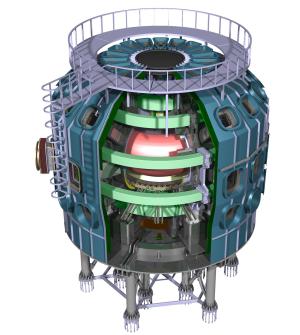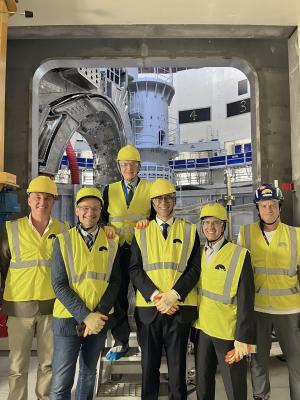An Italian "mini ITER" to explore thermal power exhaust
Fast forward more than 2,000 years and a new activity is bridging Provence with Italy. This time, not conquests or majestic arenas and temples, but nuclear fusion. Around 900 km from ITER, in Frascati, Metropolitan City of Rome Capital (20 km southeast of Rome), a new tokamak—the Divertor Tokamak Test facility (DTT)—is under construction. First proposed in 2015, the DTT project is the result of a collaboration of scientists from several Italian institutions and European fusion laboratories. In September 2019, the DTT Consortium was established with the mission to implement the project. Composed of many Italian research institutions, government and regional partners, and international stakeholders, the consortium has raised nearly EUR 500 million to construct the facility. Both DTT and ITER are expected to begin operation on roughly similar timescales.
Unlike ITER, DTT's primary mission is not to achieve deuterium-tritium fusion—it will use primarily deuterium fuel only—but to explore and test the physics and technology of concepts for exhaust of the plasma thermal power which could be used in the European DEMO (demonstration power plant) reactor, the machine Europe is planning as ITER's successor. In tokamak devices, power exhaust is usually dealt with using a special component, known as a divertor, often (as in ITER) installed at the bottom of the reactor chamber. It consists of material targets which intercept the hot plasma flowing along magnetic field lines, the geometry of which is manipulated using the external tokamak magnet coils to "divert" the plasma onto the targets. On long-pulse, high-power tokamaks, these divertors are very sophisticated, actively water-cooled components capable of handling continuously around 15 MWm-2, a colossal power flux—about the same as that found a few millimetres in front of an argon arc welding torch. Although ITER's divertor will be the largest, most complex example of this technology constructed to-date, the thermal exhaust power of a DEMO might be 4-5 times higher than the approximately 100 MW ITER's burning plasma will produce, so new power handling concepts may be needed. This is DTT's mission, to test such concepts. It is designed with a flexibility to try different divertor and magnetic geometries and, later, more esoteric approaches such as liquid metal targets which cannot be deployed on ITER.
The main goals of DTT and ITER might appear different at first sight, but look only a little deeper and you will find striking similarities between the two machines. Both are long-pulse superconducting devices (up to about 100 seconds plasma duration on DTT, about 5 times shorter than ITER's baseline for high-fusion-gain plasmas) using very similar magnet systems (18 toroidal and 6 poloidal field coils) constructed with exactly the same technology. They will each use the same double-walled, water-cooled design for the primary vacuum vessel and each will raise the plasma temperature using almost identical additional heating systems (negative ion source neutral beam injectors and wave heating in the same radio and microwave frequency ranges). DTT will begin operation with a tungsten-armoured divertor using the same technology developed for ITER and both devices will be equipped with matching sets of complex in-vessel magnet coils to be used for the control of magnetohydrodynamic plasma instabilities. If not tamed, these instabilities lead to the release of repetitive heat pulses from the confined plasma and can be very damaging to those very same divertor targets.
In short, DTT looks, for all intents and purposes, like a mini-ITER. In reality, this is no accident, since many of the DTT component designs are inspired by what has been produced for ITER, and since Europe provides many of ITER's systems (some supplied by Italian industry) it is entirely natural that similar technologies should be adopted by DTT.
It should come as no surprise then that when a delegation from the DTT Consortium visited the ITER Organization on 10 October 2022 to pursue technical discussions on how the two facilities could collaborate in the coming years during construction and beyond, many areas for cooperation were identified. In the morning of the visit, following two introductory presentations on the status of the DTT project and its planned scientific program, a three-hour marathon series of quick-fire, short talks on specific areas of engineering/technology and science on which the two devices could derive mutual benefit were given by members of the DTT team, many through videoconference. The relevant ITER staff members joined for their respective slots and brief discussions were able to establish in each case how collaborations could move forward once a formal Cooperation Agreement is signed.
In the afternoon, the delegation enjoyed a tour of the ITER Assembly Hall and Tokamak Building. A few years from now, the DTT team should be able to return the favour when their own device reaches the assembly phase. When complete, DTT will also become a facility in which the next generation of fusion scientists and engineers can be trained on a smaller device with many of the characteristics of ITER, but without the complications of nuclear operation.
We look forward to a renewal of the historic links between Italy and Provence, but now for the benefit of fusion science.



